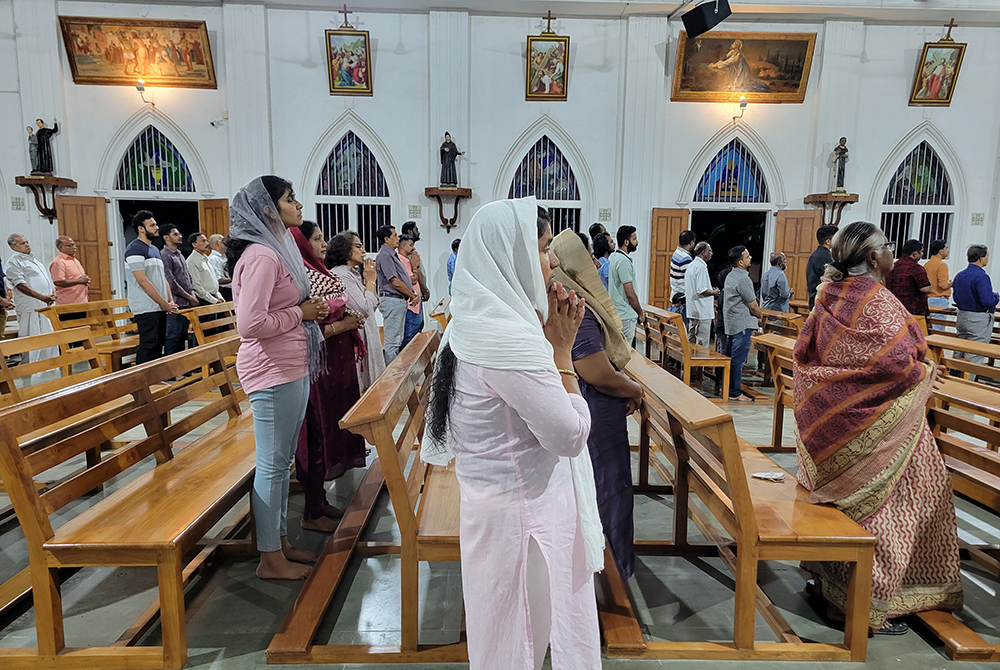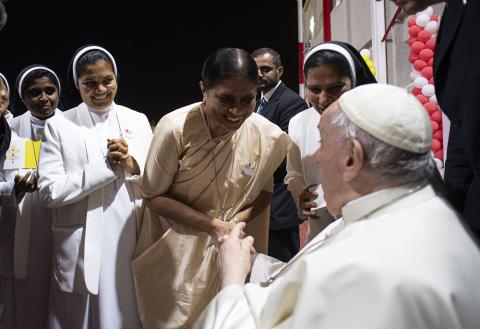
Parishioners pray during Mass at Our Lady of Mount Carmel Cathedral in Alappuzha, India, March 5, 2023. (OSV News/Barb Fraze)
On Feb. 8, 2024, Pope Francis, explained how every attempt at church reform, like the Second Vatican Council's reform of the liturgy, must be motivated by "spousal fidelity: the Church-bride will always be more beautiful the more she loves Christ the bridegroom, to the point of belonging to him totally, to the point of conforming to him fully." He said that women shouldn't be "reduced" to the ministry question.
The pope incorporated the church's role as Christ's bride into his prepared text, saying, "I want to say one thing about women's ministry. The church is a woman, the church is a mother, the church has its figure in Mary, and the church-woman, whose figure is Mary, is greater than Peter; that is, it is something else."
In the Old Testament, the book of Exodus starts with Hebrew midwives Shiphrah and Puah (Ex. 1:15), and God the Father chose them to save the Hebrew children. Likewise, so many women in the history of the Bible and Christianity have played major roles in saving people and keeping the faith alive. The role of women is indeed necessary to lead the church toward the kingdom of God.
Advertisement
Our Lord Jesus also honored women. He prioritized them. Women have taken on major roles throughout the history of the Catholic Church, especially in Europe and the United States, even in Jewish conservative societies. Of the 36 doctors of the church, four are female: Sts. Hildegard of Bingen, Catherine of Siena, Teresa of Ávila, and Thérèse of Lisieux.
When I read the words of the Holy Father, I felt it was positive news, especially in the context of Indian Catholic women. Even the most talented pious women have been reduced to the ministry level since my childhood, though there are exceptions. There are parishes in India that do not allow girls to serve at the altar, and there are parishes that have no women in parish councils.
The church has always recognized the role of Mother Mary in the salvific mission, as well as in Christianity. Today, many churches venerate Mother Mary for her holiness and the motherly care she renders to humanity.
Jesus always had high regard for women in his ministry. He treated them as equals in his mission of preaching the gospel. They accompanied him to Calvary. Mary Magdalene witnessed his Resurrection's glory.
In this way, Francis' words say that women should be given proportionate representation in the Catholic Church, as God's kingdom is for all those who obey the will of God.
It is good news for all women who want the church to treat them equally, as well as for all women who voice out the gender imbalance that has existed in the church for years.

St. Therese of Lisieux is featured holding an image of the Holy Face in this stained glass depiction of beloved female saints in the church of St. Therese, Montauk, New York. Illustrated are Sts. Teresa Benedicta of the Cross, Teresa of Avila, Therese of Lisieux and Catherine of Siena. (OSV News/Gregory A. Shemitz)
In many cases, women's participation in the church has been reduced to reciting prayers, cleaning the church premises and decorating, and assisting in many other church-related activities and programs. It is a shame, as there are many well-educated women with good training in theology who could preach sermons.
It would be appropriate to treat women and men equally in terms of dignity and respect. That is our desire — to see a just and inclusive society. This is a realization that most every woman and girl, at some point in their lives, aspires to.
Believing in equality is one thing, consistently standing up for it is another. Many people aspire to an egalitarian society, but when faced with the realities of making it happen, they often falter in their responsibility, commitment and conviction.
When I was serving as the program coordinator of the Catholic Bishops' Conference of India, I noticed that in many of the programs, the stage was filled up with bishops, priests and laymen. It was always surprising to me. I observed that even priests who advocate for gender equality overlooked this issue. One day, I went up to the bishop in charge and requested that he make a change. He promised to do so. From that day on, we consistently ensured women's representation in all of our seminars and conferences.
In my work, I consistently ensure the inclusion of women in all programs, whether as participants or resource persons. I have accompanied bishops and priests to numerous seminars and meetings, giving women priority due to their gender.
It is always men who are elected as the chairpersons or presidents of the episcopal conferences and the bishops' councils, and religious and lay women are seldom elected to be secretaries. In the bishops' councils, there are very few women who serve as secretaries of the women's commissions. Yet, it is not against the rules of the Code of Canon Law for consecrated women to take administrative roles in the Catholic Church as there are already many women taking up leadership roles at the Vatican.
Believing in equality is one thing, consistently standing up for it is another.
One example of this is Sr. Inigo Joachim, the former superior general of St. Anne's Sisters of Madhavaram, Chennai, Tamil Nadu, India, who recently spoke at an online course on religious vows, "The Vows in Line with the Signs of the Times," on May 9 and 10.
I wish the Catholic Church in India would encourage more women leaders, as the Holy Father suggests. The remarkable lives and service of numerous women's congregations have significantly aided the faithful in areas such as faith, education and health care. And yet, there is still a long way to go. There is a dire need for women's religious congregations to train women to take up leadership roles in the church, such as being the procurators in the dioceses, as they are part of the diocesan administration.
In November 2021, the Conference of Religious India, the national body of major superiors of India's Catholic religion, elected Sr. Maria Nirmalini, an Apostolic Carmel, as its president. We must sustain the good examples we have.
Like any society, India boasts numerous exceptional examples of women leaders who have achieved empowerment through various means, despite numerous challenges.
Thus, one of the debating ideas of equality between men and women in societal issues and its other ramifications in life is a matter of great interest to me as a person, a woman and a nun.

Sr. Maria Nirmalini, the superior general of the Apostolic Carmel congregation, and sisters of the Apostolic Carmel congregation meet with Pope Francis in Bahrain in November 2022. (Vatican Media/Francesco Sforza)
The Holy Bible teaches us that God created humankind [a] in his image, in the image of God, he created them; [b] male and female, he created them (Genesis 1:27).
God created women and men in his image, which brings clarity that all are equal and there should be no differences in treating and respecting both genders. Striking for an equal and inclusive society is both the value of God's kingdom and the need of the hour.
At times, even educated Christian women and men propagate the idea that men and women are not equals. In India, it is customary for women to cover their heads in churches during Holy Mass. During a catechism seminar, we engaged in a discussion about the necessity of head covering. A well-educated woman opposed it, saying that we can't change the traditions of the church.
This could be due to patriarchy, male-dominated hegemony, or age-old practices, customs and traditions that perpetuate discrimination against women.
God's creation of women and men is not about comparison, but about cherishing the beauty of God's creativity in each of them. Together, men and women play complementary roles in executing the building of the kingdom of God, each with their responsibilities and rights.
Women in the church need to raise concerns about gender equality and work toward changing patriarchal beliefs and customs. Like-minded men must collaborate in this process to eliminate the cultural divide within the Indian church. It needs willing and committed people ready to see an equal, inclusive church where women can also be included in the mission of the church.





